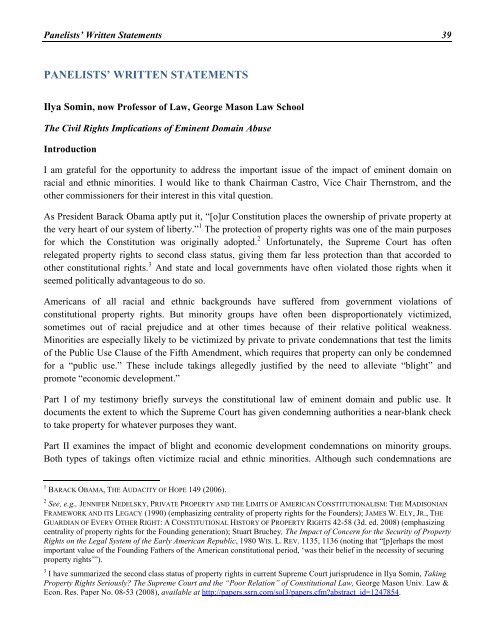Create successful ePaper yourself
Turn your PDF publications into a flip-book with our unique Google optimized e-Paper software.
Panelists’ Written Statements 39PANELISTS’ WRITTEN STATEMENTSIlya Somin, now Professor of Law, George Mason Law SchoolThe Civil Rights Implications of <strong>Eminent</strong> <strong>Domain</strong> AbuseIntroductionI am grateful for the opportunity to address the important issue of the impact of eminent domain onracial and ethnic minorities. I would like to thank Chairman Castro, Vice Chair Thernstrom, and theother commissioners for their interest in this vital question.As President Barack Obama aptly put it, “[o]ur Constitution places the ownership of private property atthe very heart of our system of liberty.” 1 The protection of property rights was one of the main purposesfor which the Constitution was originally adopted. 2 Unfortunately, the Supreme Court has oftenrelegated property rights to second class status, giving them far less protection than that accorded toother constitutional rights. 3 And state and local governments have often violated those rights when itseemed politically advantageous to do so.Americans of all racial and ethnic backgrounds have suffered from government violations ofconstitutional property rights. But minority groups have often been disproportionately victimized,sometimes out of racial prejudice and at other times because of their relative political weakness.Minorities are especially likely to be victimized by private to private condemnations that test the limitsof the Public Use Clause of the Fifth Amendment, which requires that property can only be condemnedfor a “public use.” These include takings allegedly justified by the need to alleviate “blight” andpromote “economic development.”Part I of my testimony briefly surveys the constitutional law of eminent domain and public use. Itdocuments the extent to which the Supreme Court has given condemning authorities a near-blank checkto take property for whatever purposes they want.Part II examines the impact of blight and economic development condemnations on minority groups.Both types of takings often victimize racial and ethnic minorities. Although such condemnations are1 BARACK OBAMA, THE AUDACITY OF HOPE 149 (2006).2 See, e.g., JENNIFER NEDELSKY, PRIVATE PROPERTY AND THE LIMITS OF AMERICAN CONSTITUTIONALISM: THE MADISONIANFRAMEWORK AND ITS LEGACY (1990) (emphasizing centrality of property rights for the Founders); JAMES W. ELY, JR., THEGUARDIAN OF EVERY OTHER RIGHT: A CONSTITUTIONAL HISTORY OF PROPERTY RIGHTS 42-58 (3d. ed. 2008) (emphasizingcentrality of property rights for the Founding generation); Stuart Bruchey, The Impact of Concern for the Security of PropertyRights on the Legal System of the Early American Republic, 1980 WIS. L. REV. 1135, 1136 (noting that “[p]erhaps the mostimportant value of the Founding Fathers of the American constitutional period, ‘was their belief in the necessity of securingproperty rights’”).3 I have summarized the second class status of property rights in current Supreme Court jurisprudence in Ilya Somin, TakingProperty Rights Seriously? The Supreme Court and the “Poor Relation” of Constitutional Law, George Mason Univ. Law &Econ. Res. Paper No. 08-53 (2008), available at http://papers.ssrn.com/sol3/papers.cfm?abstract_id=1247854.


